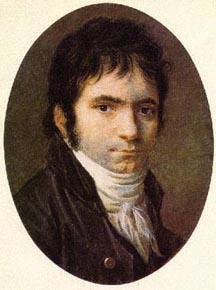Composed 1797-8; 20 minutes
Beethoven’s three Op. 12 violin sonatas take advantage of recent technical advances in violin technique and bow design to help the violin compete on a more even playing field with the sonorities and articulation of the piano. Beethoven was fully up to speed on developments in violin technique, having taken lessons from both Ignaz Schuppanzigh and Wenzel Krumpholz, two notable violinists of the day, almost as soon as he moved to Vienna. As a virtuoso pianist, renowned for his improvisations on the piano, he was also keenly aware of the substantial increases in sonority, sustaining power and tonal range of the quickly evolving piano. The Op. 12 sonatas bring together the two instruments that were a prime focus of Beethoven’s attention in 1797, and which motivated him to look forward and embrace developments, rather than keep to the status quo.
After a brief opening flourish for both instruments, the lyrical opening melody of the D major sonata is given first to the violin and then echoed on piano. Beethoven’s assertive writing for the violin immediately brings home his concept of the duo sonata, calling for considerable technical and musical expertise from both instrumentalists. Neither instrument predominates to the exclusion of the other. The most striking moments come in the slow movement. After shining the spotlight on first the piano then the violin, Beethoven’s minor key variation, with its rapid alternation of loud and soft and bold key changes, produces what a 1799 reviewer of the music described as “obstinacy which fails to interest us, a striving for strange modulations, an objection to customary harmonic progressions, a heaping up of difficulties on difficulties.” Exactly! The conclusion of the movement takes us even further into the young Beethoven’s fertile imagination. The sonata ends with a galloping, good natured rondo finale.

Created as a miniature on ivory, this portrait of Beethoven was made in 1803 by Danish miniature painter Christian Hornemann.